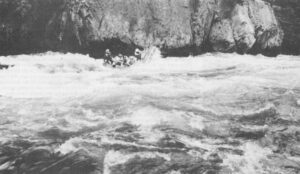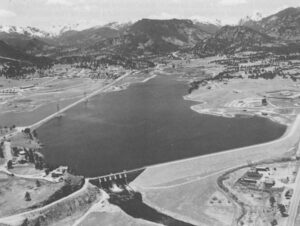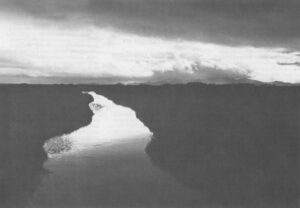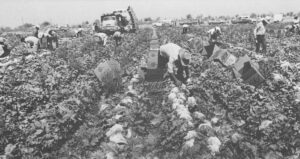(CALIFORNIA) — A few months ago I flew over the state of Utah on my way back from Washington to San Francisco. It was a late night in November, and a fierce early blizzard had swept out of the Rocky Mountain States. I had an aisle seat, and since I believe that anyone who flies in air airplane and does not look out the window most of the time wastes his money, I went back to one of the doors adjoining the rear galley of the airplane, a DC-10, and stood there for a long time, lulled by the heavy drone of the engines, staring out the door’s tiny aperture. The frozen fire of a winter’s moon poured cold light on the desert below. Six inches away from the tip of my nose the temperature was minus sixty-five degrees, and seven miles below it was, according to the pilot, nine above zero, but here we were, two hundred highly inventive creatures safe and comfortable in a fat winged cylinder racing over the Great Basin of North America, dozing, drinking, chattering, oblivious to the frigid emptiness outside.
Emptiness. There was nothing down there on the earth — no towns, no lights, no signs of any kind of civilization. Barren mountains rose duskily from the desert floor; mesas and isolated buttes broke the lifeless, wind-scoured reaches. It was a magnificent but repellent landscape — an unformed, unfinished, unwatered, untenanted part of the sun’s green planet. A place waiting for life to begin; a Mars on Earth.
Suddenly a line of peaks — a high, thin cordillera — heaved up underneath us. We were crossing the Wasatch Mountains, the sentinels of the Salt Lake Basin. We drifted over their snow-peaked ramparts and then, as the mountains fell away, a gridiron of lights appeared below. It was heavily clustered directly under us and trailed off to the south, winking, and shimmering in the night. We were over most of the population of Utah.
I remember thinking what a poignant sight it was, that thin glowing avenue of civilization pressed up against the still mountains. It seemed remarkable to me that it had been down there only about a hundred and thirty years, since Brigham Young crossed the high mountain Pass and settled his band of social outcasts by the old bed of a dying inland sea. Like beavers arriving at a pond, the Mormons had, within hours of ending their ordeal of migration, dug shovels into the earth beside the streams draining the Wasatch Range, cutting canals into the desert that they would convert to fields that would nourish them. They had literally reinvented irrigation, mastering its challenges and subtle intricacies as no others on this continent would, and they took their skills elsewhere — to California, to Idaho, to Arizona — planting the seeds of permanent settlement in the American West. I should confess that I have always found the idea of colonizing the desert a little crazy, but I felt myself fairIy aching with pride at the sight of Salt Lake City glowing magnificently amid the moonlit desolation of Utah. It may have been madness, but it was heroic madness, indeed.
On the other hand, what has it all amounted to?
If one stares for a while at a Landsat photo of the West, one sees the answer: not all that much. Most of Utah remains an untrammeled desert; much of the West has felt only the tracks of nomadic men. Each nucleus of population — there are, outside of California and the Pacific Northwest, about a dozen and a half cities with more than 50,000 inhabitants, in an area the size of all of Europe — is separated from the others by yawning stretches of loneliness. Despite the billions spent on dams and canals, despite the unaccountable toil and tears, only 35 million acres, a statistically invisible percentage of the country’s land mass, has been irrigated.
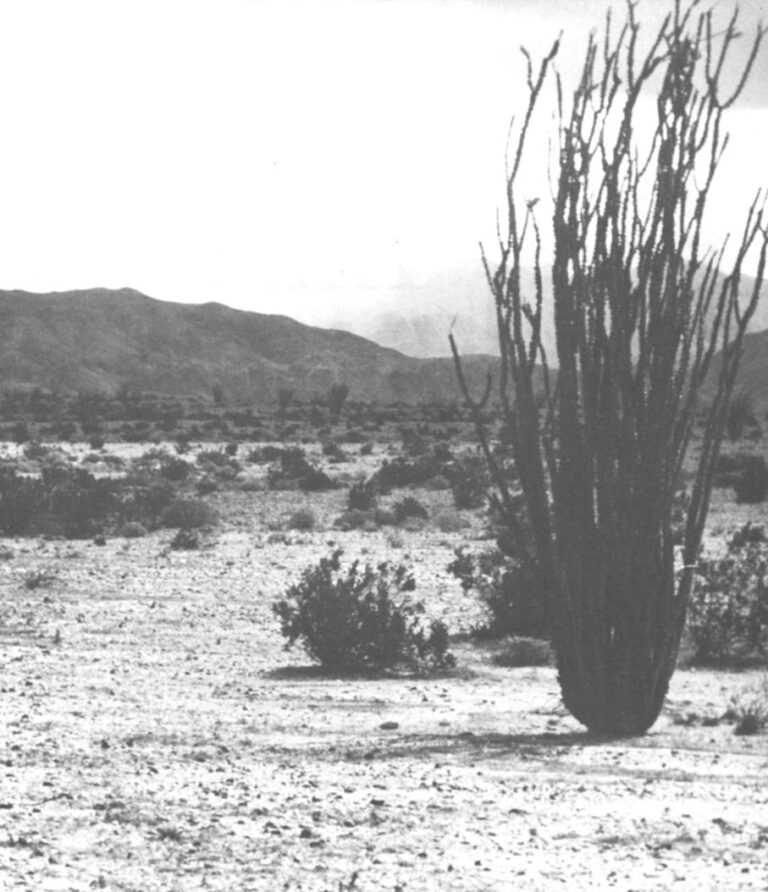
The land is too big. It is too dry and too high and too hot and too cold. It is barren, unyielding, grandiosely indifferent. It was not left for us to inhabit but for giants: for nomadic monsters who thrive in extremes of climate; who use water as an incidental pleasure, not a fundamental necessity of life; who would not be shrunken to oblivion by the limitlessness of the terrain around them.
One does not conquer a landscape such as this. One inhabits it like an occupying army, and makes, at best, an uneasy truce with it. The wild forests of New England were felled for pastures and the vast swamplands that covered the South were turned into cotton fields, but we will never visit such changes on the West. The great ecologist Aldo Leopold observed half a century ago that all of the water wouldn’t begin to irrigate all of the land, and he gave us some prescient advice: get used to that fact. We never have, and I doubt that we ever will. For even if technology fails and money falls short and politics becomes paralysis, the western imagination will persist.
“This is the dead land/This is the cactus land… Between the idea/and the reality… Between the conception/and the creation … Between the potency/And the Existence…” It was these lines of T.S. Eliot, quoted in an article by George Sibley on the Colorado River which appeared in Harper’s a couple of years ago, that started me thinking about the western imagination.
That there is such a thing I have no doubt. To fathom it one must first realize — and I’m not sure many easterners do — that all those who live in the arid West inhabit a landscape that regards them with a kind of arch, withering contempt. There are to be sure, some inhospitable parts of the East, places that can be bitterly cold, like my hometown of Minneapolis; blazingly hot, like my hometown of Minneapolis; unrelievedly flat, like Indiana; or impossibly hilly and rugged, like most of West Virginia. But the West has all of these extremes, and then a further one, the ultimate one: no water. I think to anyone whose cultural reflexes were formed by places other than the desert — a category which would include most Americans of North European, African, and Asian descent — there is something disastrously wrong about a place with no water. We are, after all, mostly water, and a place without it mocks us, rejects us: it violates us.
I have had people, easterners and westerners alike, tell me that they love the desert, but few of these people would ever Iive there — I mean in the real desert, not a place that happens to be situated there and tries to look like Cleveland or Miami. I don’t know if they have ever walked in the desert. They merely drive through, in air-conditioned cars, and “experience” its “grandeur”.
That may be an expensive, but it is a fool’s vision. To really experience the desert one has to get out of one’s car and step off into it, march into the broiling, glistening heat with one’s mind on one’s canteen as if it were an undersized gas tank and one were being chased by a carload of murderers. One has to think what it would be like to try to suck wetness out of sagebrush, or, in the grip of dementia, exhaust oneself clawing barehanded through sand and rock for the vestigial moisture of a dry wash.
This is the real desert. Drive through it sometime and watch where the trees grow — the trees, which are, because of their moisture requirements, our closest spiritual relatives in the kingdom of plants. They appear near the tops of mountains, usualIy over 7,000 or 8,000 feet, or else they are huddled together like cows along waterless streambeds. High up there is obviously more rain, but the soil is miserable and the weather is too extreme for crops or man. Lower down the soil and weather are better but it may not rain for seven months at a spell — rain clouds do not mean rain in the desert, because the heat coming off the ground can vaporize a shower in midair, leaving the blackest cumulonimbus trailing a few pathetic ribbons of precipitation — and even if a raindrop reaches the ground there is nothing to hold it, so it seeks other drops and they run off together in angry brown torrents, evaporating, racing to nowhere.
So what does one say about thirty million Americans who have chosen to inhabit this kind of a place? Well, they may live there, but I refuse to believe that they have made any peace with it. Look at their watered lawns, green as Kentucky. Look at the elms and maples and coconut palms that shade their houses (the state capitol grounds in Sacramento, where it rains seventeen inches a year, look as if Virginia had mated with Borneo). Look at how they flaunt the desert: The big attraction in Phoenix is its fountain, an inspired piece of pretentious waste shooting water higher than a skyscraper into 118 degree skies. Lake Havasu City, a Disneyland town with no pretense of fantasy — that is another thing about the modern West, the blurring of reality — bought London Bridge and reassembled it, stone by water-stained stone, across an arm of an artificial lake in a place visited by rainfall perhaps three or four times a year.
Such things are fruits of the western imagination, and there will be more to come. As Napoleon could not look at the European continent without thinking of conquest, westerners cannot look around them without thinking of change. “Think what we could grow on all this land.” “Think how many people we could move into these deserts.” “Think what we could do with the water in that (name any one) river.” These are standard refrains, constantly repeated. The rest of the nation may shackle itself into ecological consciousness, may finally be content to leave its habitat alone, but the West never will. You don’t believe it? Well, then, consider the Sagebrush Rebellion, a political firestorm over eastern ecological values imposed by eastern (or traitorous western) bureaucrats, which has, when one considers the subsidies and protection provided by the mother governments, about as much justification as the revolution fomented by the ne’er-do-wells and acquisitive gentry who were our founding fathers. Consider the theological reaction against the President’s water projects hit lists. Consider Los Angeles sitting in a multiple-hazard zone and spilling into the Mojave Desert and thirsting after the Columbia River.
Westerners love the potency more than the Existence, and one achieves the potency by impounding water. As Joan Didion, the best living western writer, observes, “water is the only natural force over which we have any control out here.” Didion wrote a famous essay, “Holy Water”, after a visit to the nerve center of California, the giant Univac in the command room of the State Water Project in Sacramento, and she felt some powerful urges there: “I wanted to open and close the Clifton Court Forebay intake gate. I wanted to produce some power down at San Luis Dam. I wanted to pick a pool at random on the aqueduct and pull it down and refill it, watching for the hydraulic jump.” Now there’s an honest westerner, one who realizes that her kind are the last real Yankees — the gatekeepers of nineteenth century American innocence — and water development is their Chautauqua.
It may be their Waterloo.
At a recent prayer breakfast in Sacramento, the canescent spiritual leader of California, Governor Edmund G. Brown, Jr., once again gave us his view of why things are not right in the world. “The ethic of throwaway planned obsolescence, accumulation, and military definitions of what are essentially human needs,” the Governor preached, must be replaced by “an ethic of stewardship, an ethic of conservation … an ethic of frugality.” We have heard it all before.
But what do the exhortations mean? Frugality? Conservation? Those are odd words coming from a governor who is championing a water project which may turn out to be the single most expensive thing man has ever built — certainly the most expensive thing any state has ever built. This item is Phase Two of the State Water Project: a 400-foot wide canal, a nine million acre-foot storage reservoir, a smaller but hardly piddling reservoir, forebays, afterbays, pumps, siphons, more pumps, more siphons, headgates, fish screens, surges, a large coal-fired power plant and a couple of geothermal plants just to run the thing, and a probable cost, by the state’s own admission, of twenty-three billion dollars, allowing for inflation. Some members of the Brown Administration have privately expressed shock that the project will cost so much. Someone ought to remind them of what the late Senator Everett Dirksen once said: “A billion here and a billion there, and pretty soon you’re talking about real money.”
The project which the frugal and conservationist Brown Administration wants to build so badly is designed for one thing and one thing only: more growth around Los Angeles, and more agriculture in the deserts of the southern San Joaquin Valley. It is viewed as salvation by the irrigators and the city fathers of Los Angeles, who are always “running out of water”. However, it is conceivable — not too likely yet, but conceivable — that Phase Two will make the State Water Project run out of money. More and more, it looks like a big-finned Chrysler driven into the Age of Hondas.
By the time Phase Two of the State Water Project is ready to operate, energy and construction costs will be so outlandish that the melded price of water (the average price of cheap old water and expensive new water) could be three or four times higher than it is today even in 1980 dollars. I use the subjunctive “could be” because history teaches that, when the real price of water rises higher than the price that irrigators and domestic consumers are willing to pay, government makes up the difference with hidden subsidies. However, even a state as wealthy as California cannot subsidize a twenty odd billion dollar project to any great degree, so the price of delivered water is certain to rise meteorically in the years ahead. In such a case people will conserve, and that could be calamitous.
The use of irrigation water (and to a lesser extent domestic water) is, to obvert the economists’ term, elastic, because most water delivered in our era of limits was first developed in the Golden Age of Plentitude. The price is unreasonably low; the waste, principally in irrigation, is unreasonably high; and some of the end purposes — such as irrigating pasture land in California to fatten calves raised in Texas and bound for Iowa — are, one might reasonably argue, ridiculous. If alfalfa or irrigated pasture lands are converted to orchards and drip irrigation systems are installed, and then a few advertising agencies are hired to convince people that they need to eat more fruit and less beef, the water savings will be on the order of 80 percent. Much simpler stuff — leveling land with lasers, for example, or hiring a couple of additional workers to manage one’s irrigation system more efficiently — can yield smaller but appreciable savings.

In short, as the price of water goes up users are certain to save more, and they may be able to save a great deal in California because the waste of water is, by any standard, immense. As people conserve, the demand for water will drop, and revenues may be insufficient to pay back the colossal revenue bonds that will be needed to finance Phase Two of the State Water Project. Then the price will have to be raised even further, prompting people to conserve more. And so the wheel will turn, and where it will stop no one knows; it may go careening, carving a path of wreckage through the economy of the nation’s wealthiest state. California had a relatively painless opportunity to learn this lesson during the drought of 1977, when higher rates were the reward of homeowners who conserved the most water. But the Brown Administration has chosen to ignore Santayana. It is in the grip of the western imagination.
Sometimes I wonder where it is going to end. Perhaps it will never end. We will soon be paying a hundred billion dollars a year for imported oil, and our balance of payments deficits are already terrorizing. By encouraging millions of people to leave the freezing, decrepit cities of the Northeast for the warm, solar-cooled Southwest of the future, we could save a lot of oil. Then it might finally seem worthwhile orchestrating some of the Mississippi River toward New Mexico and Arizona. If food exports become our economic salvation, as seems unlikely, and a terrible drought strikes the Midwest — something that is statistically predictable — then irrigated agriculture, safe and secure from the vagaries of rainfall, might look like the best investment in the nation’s future. As the ancient water supply systems of cities such as Boston and New York steadily disintegrate (about a third of Boston’s water is lost before it even reaches the taps) we may see an East-West axis develop: you give us our water projects, and we’ll give you yours. Is it mere coincidence that a bill which would, in effect, forge such an alliance, distributing federal money to states on the basis of geographic area and population density, has been introduced by Senator Daniel Moynihan (of New York) and Senator Peter Domenici (of New Mexico)?
Whether the West needs more water development can be argued over interminably. After studying the situation for a year I don’t believe it does; it is time we tried greater efficiency rather than more dams. Whether we can even afford to develop much more water and have any money left in the treasury — not to mention water in our rivers — is debatable. But I’m not sure it matters. The western imagination will always be there, dreaming in the dry stillness of the desert heat. Somehow it has to be stilled first.
The next glow of civilization after Salt Lake City would be Reno, 600 miles away. I remembered two things about Reno. The average annual rainfall there is 7.3 inches — about a month’s worth of rain in Mobile. And, though gambling and prostitution are legal in Reno, water metering is against the law.
©1979 Marc Reisner
Marc Reisner ends his fellowship study on the Effects of the Federal Government’s Water Resources Policies on the Nation with this issue.



